bonnet FIAT SEICENTO 2007 1.G Owners Manual
[x] Cancel search | Manufacturer: FIAT, Model Year: 2007, Model line: SEICENTO, Model: FIAT SEICENTO 2007 1.GPages: 154, PDF Size: 3.68 MB
Page 52 of 154
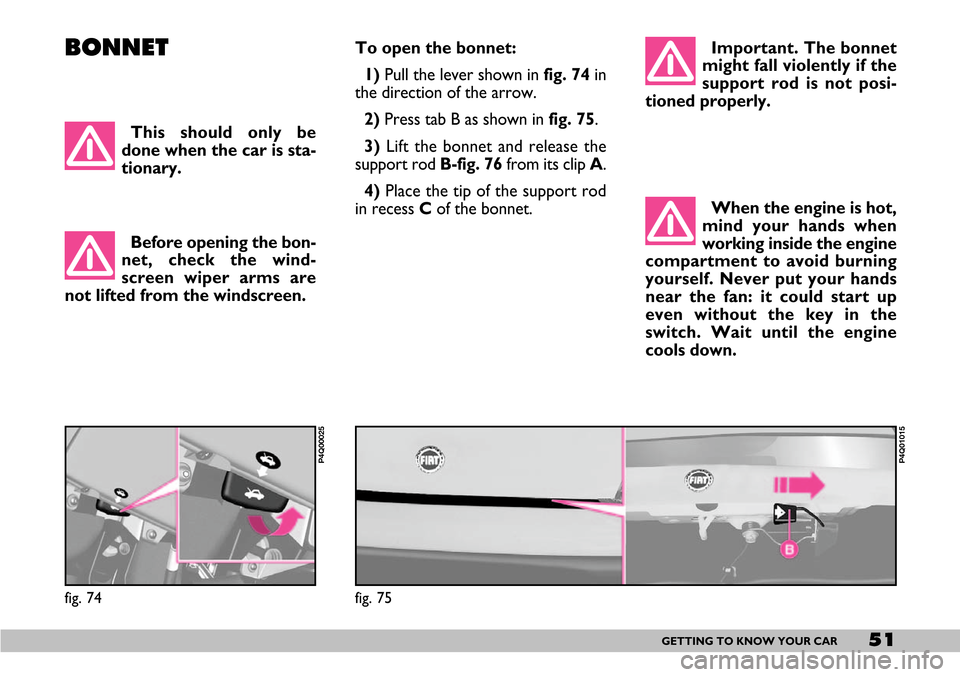
51GETTING TO KNOW YOUR CAR
BONNETTo open the bonnet:
1) Pull the lever shown infig. 74in
the direction of the arrow.
2)Press tab B as shown in fig. 75.
3) Lift the bonnet and release the
support rod B-fig. 76from its clip A.
4)Place the tip of the support rod
in recess C of the bonnet.Important. The bonnet
might fall violently if the
support rod is not posi-
tioned properly.
This should only be
done when the car is sta-
tionary.
Before opening the bon-
net, check the wind-
screen wiper arms are
not lifted from the windscreen.
When the engine is hot,
mind your hands when
working inside the engine
compartment to avoid burning
yourself. Never put your hands
near the fan: it could start up
even without the key in the
switch. Wait until the engine
cools down.
fig. 74
P4Q00025
fig. 75
P4Q01015
Page 53 of 154
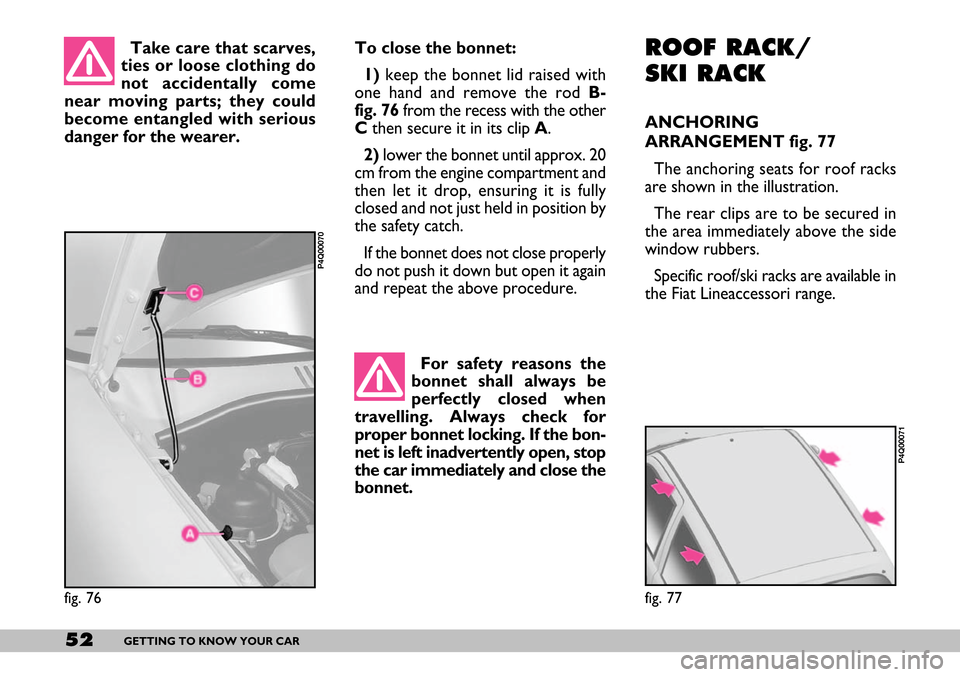
52GETTING TO KNOW YOUR CAR
Take care that scarves,
ties or loose clothing do
not accidentally come
near moving parts; they could
become entangled with serious
danger for the wearer. To close the bonnet:
1)keep the bonnet lid raised with
one hand and remove the rod B-
fig. 76from the recess with the other
Cthen secure it in its clip A.
2) lower the bonnet until approx. 20
cm from the engine compartment and
then let it drop, ensuring it is fully
closed and not just held in position by
the safety catch.
If the bonnet does not close properly
do not push it down but open it again
and repeat the above procedure.ROOF RACK/
SKI RACK
ANCHORING
ARRANGEMENT fig. 77
The anchoring seats for roof racks
are shown in the illustration.
The rear clips are to be secured in
the area immediately above the side
window rubbers.
Specific roof/ski racks are available in
the Fiat Lineaccessori range.
For safety reasons the
bonnet shall always be
perfectly closed when
travelling. Always check for
proper bonnet locking. If the bon-
net is left inadvertently open, stop
the car immediately and close the
bonnet.
fig. 76
P4Q00070
fig. 77
P4Q00071
Page 111 of 154
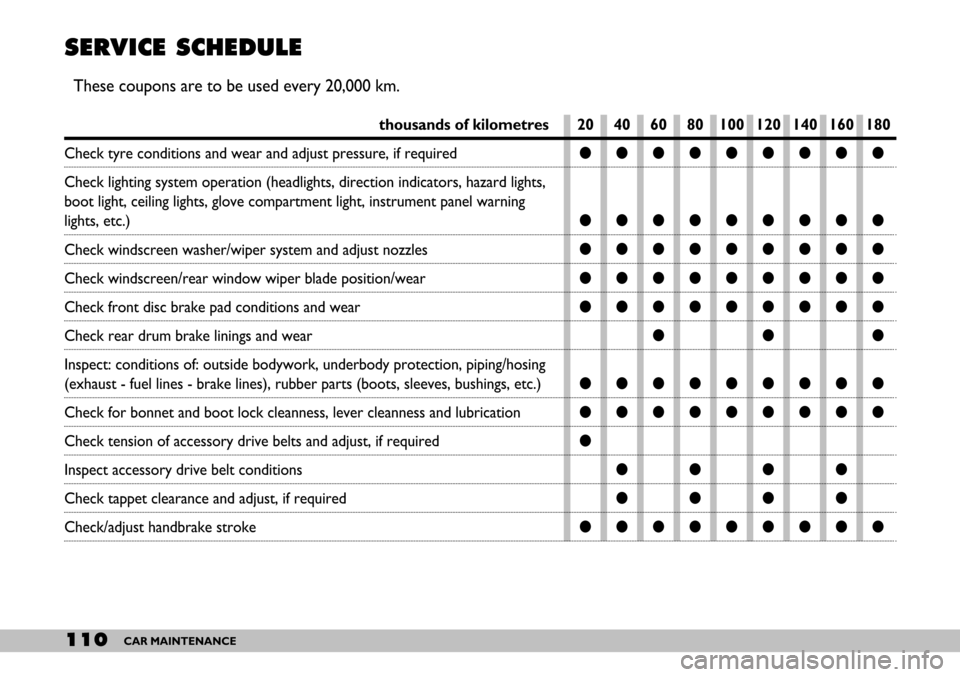
110CAR MAINTENANCE
SERVICE SCHEDULE
These coupons are to be used every 20,000 km.
thousands of kilometres
Check tyre conditions and wear and adjust pressure, if required
Check lighting system operation (headlights, direction indicators, hazard lights,
boot light, ceiling lights, glove compartment light, instrument panel warning
lights, etc.)
Check windscreen washer/wiper system and adjust nozzles
Check windscreen/rear window wiper blade position/wear
Check front disc brake pad conditions and wear
Check rear drum brake linings and wear
Inspect: conditions of: outside bodywork, underbody protection, piping/hosing
(exhaust - fuel lines - brake lines), rubber parts (boots, sleeves, bushings, etc.)
Check for bonnet and boot lock cleanness, lever cleanness and lubrication
Check tension of accessory drive belts and adjust, if required
Inspect accessory drive belt conditions
Check tappet clearance and adjust, if required
Check/adjust handbrake stroke20 40 60 80 100 120 140 160 180
●●●●●●●●●
●●●●●●●●●
●●●●●●●●●
●●●●●●●●●
●●●●●●●●●
●●●
●●●●●●●●●
●●●●●●●●●
●
●●●●
●●●●
●●●●●●●●●
Page 113 of 154

112CAR MAINTENANCE
ANNUAL INSPECTION SCHEDULE
– Inspect conditions of. engine, gear-
box, transmission, piping (exhaust -
fuel feed - brakes), rubber parts
(boots - sleeves - bushings - etc.),
brake and fuel line hoses.
– Check for bonnet and boot lock
cleanness, lever cleanness and lubri-
cation.
– Check battery charge status.
– Check conditions of various con-
trol belts.
– Check and top up fluid levels (en-
gine coolant, brakes, windscreen
washer, battery, etc.).
– Change engine oil.
– Replace engine oil filter.
– Replace pollen filter (where fitted). The following annual inspection
schedule is recommended for
cars travelling less than
20,000 km a year (e.g. approxi-
mately 10,000 km). The schedule
includes the following operations:
– Check tyre condition and wear
and adjust pressure, if required (in-
cluding spare wheel).
– Check operation of lights (head-
lights, direction indicators, hazard
lights, boot light, passenger compart-
ment ceiling light, glove compartment
light, instrument panel lights, etc.).
– Check windscreen wiper/washer
and adjust nozzles.
– Check position wear of wind-
screen/rear window wiper blades.
– Check front brake pad conditions
and wear.
ADDITIONAL
CHECKS
Every 1,000 kmor before long
trips, check and top up as necessary:
– engine coolant level, brake fluid
level, windscreen washer liquid level,
tyre pressure and conditions.
Every 3,000 kmcheck and top up
as necessary: engine oil level.
We recommend using FL Selenia
products which were specifically de-
signed and made for use in Fiat vehi-
cles (see
CAPACITIEStable in TECHNICAL
SPECIFICATIONS
).
Page 116 of 154
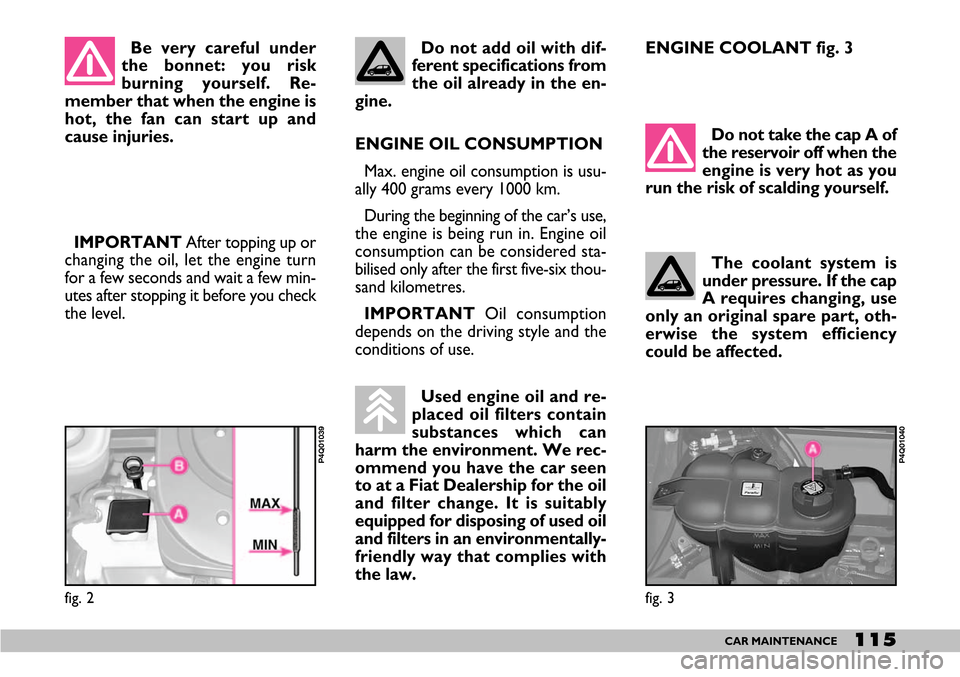
115CAR MAINTENANCE
Be very careful under
the bonnet: you risk
burning yourself. Re-
member that when the engine is
hot, the fan can start up and
cause injuries.
ENGINE OIL CONSUMPTION
Max. engine oil consumption is usu-
ally 400 grams every 1000 km.
During the beginning of the car’s use,
the engine is being run in. Engine oil
consumption can be considered sta-
bilised only after the first five-six thou-
sand kilometres.
IMPORTANTOil consumption
depends on the driving style and the
conditions of use. IMPORTANT After topping up or
changing the oil, let the engine turn
for a few seconds and wait a few min-
utes after stopping it before you check
the level. Do not add oil with dif-
ferent specifications from
the oil already in the en-
gine.
fig. 2
P4Q01039
Used engine oil and re-
placed oil filters contain
substances which can
harm the environment. We rec-
ommend you have the car seen
to at a Fiat Dealership for the oil
and filter change. It is suitably
equipped for disposing of used oil
and filters in an environmentally-
friendly way that complies with
the law.
ENGINE COOLANT fig. 3
Do not take the cap A of
the reservoir off when the
engine is very hot as you
run the risk of scalding yourself.
The coolant system is
under pressure. If the cap
A requires changing, use
only an original spare part, oth-
erwise the system efficiency
could be affected.
fig. 3
P4Q01040
Page 120 of 154
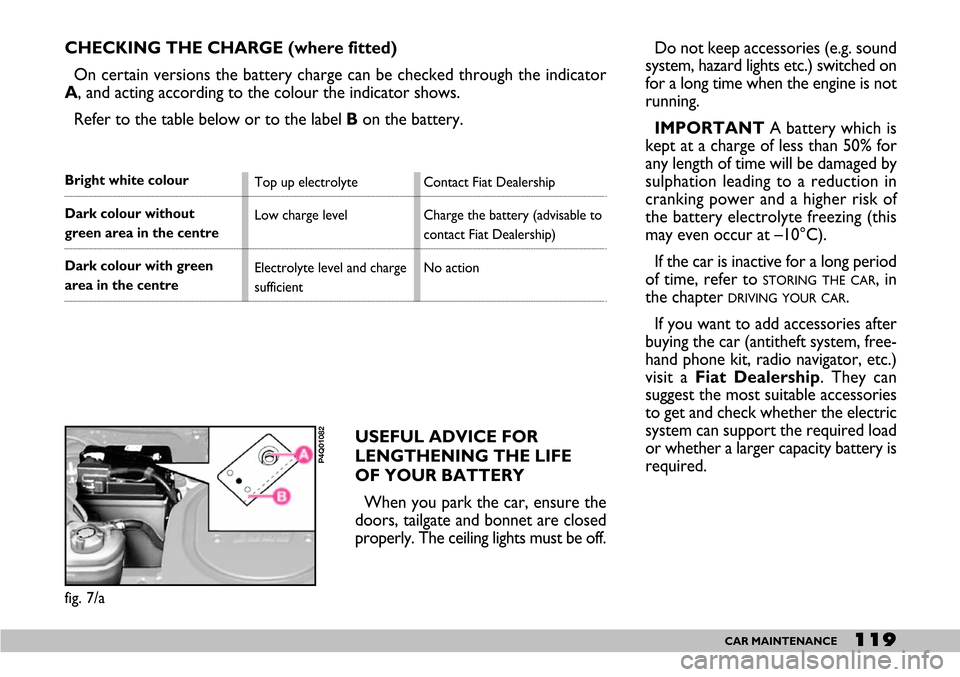
119CAR MAINTENANCE
Do not keep accessories (e.g. sound
system, hazard lights etc.) switched on
for a long time when the engine is not
running.
IMPORTANTA battery which is
kept at a charge of less than 50% for
any length of time will be damaged by
sulphation leading to a reduction in
cranking power and a higher risk of
the battery electrolyte freezing (this
may even occur at –10°C).
If the car is inactive for a long period
of time, refer to
STORING THE CAR, in
the chapter
DRIVING YOUR CAR.
If you want to add accessories after
buying the car (antitheft system, free-
hand phone kit, radio navigator, etc.)
visit a Fiat Dealership. They can
suggest the most suitable accessories
to get and check whether the electric
system can support the required load
or whether a larger capacity battery is
required. USEFUL ADVICE FOR
LENGTHENING THE LIFE
OF YOUR BATTERY
When you park the car, ensure the
doors, tailgate and bonnet are closed
properly. The ceiling lights must be off.
Top up electrolyte
Low charge level
Electrolyte level and charge
sufficientContact Fiat Dealership
Charge the battery (advisable to
contact Fiat Dealership)
No action
CHECKING THE CHARGE (where fitted)
On certain versions the battery charge can be checked through the indicator
A, and acting according to the colour the indicator shows.
Refer to the table below or to the label Bon the battery.
Bright white colour
Dark colour without
green area in the centre
Dark colour with green
area in the centre
fig. 7/a
P4Q01082
Page 127 of 154

126CAR MAINTENANCE
Engine compartment
At the end of each winter season,
carefully clean the engine compart-
ment. Have this done at a garage. Leave the car in the open so that the
water can evaporate.
Do not wash the car after it has
been parked in the sun or while the
bonnet is hot: it could take the shine
off the paint.
Outside plastic parts must be
cleaned following the usual car wash-
ing procedure.
Where possible avoid parking the
car under trees; the resinous sub-
stances that certain species of tree
shed dull the paintwork and increase
the possibility of rust forming.
IMPORTANT Bird droppings
must be washed off immediately and
with great care as their acid is partic-
ularly aggressive.Detergents pollute wa-
ter. The car must there-
fore be washed in an area
equipped for the collection and
purification of the liquids used
while washing.
IMPORTANTThe engine com-
partment should be washed while the
engine is cold and with the ignition key
at STOP. After washing, make sure
that the various protections (e.g. rub-
ber boots and various guards) have
not be removed or damaged. To better protect the paintwork,
polish with specific protective wax.
When the paintwork tends to lose
its shine because of the build-up of
smog, use polish wax which has a
slightly abrasive as well as protective
action.
Windows
Use specific window cleaners to
clean the windows. Use very clean
cloths to avoid scratching the glass or
damaging its transparency.
IMPORTANT To prevent damage
to the electrical heater element, wipe
the inside of the heated rear window
gently in the same direction as the el-
ements.
Page 146 of 154

145INDEX
I I I I
N N N N
D D D D
E E E E
X X X X
ABS ............................................ 54
Accessories purchased by the
owner ......................................... 66
– Installation of electric/
electronic devices ................ 67
– Radio transmitters and
cellular telephones ............... 67
Air filter ....................................... 117
Air recirculation ......................... 35
Air vents (adjustable) ................ 33
Front airbags ............................... 56
– front airbag passenger side 57
– general warnings .................. 58
– front airbags .......................... 576
Analogue clock ........................... 24
Ashtray ......................................... 42
At the filling station ................... 66
Battery
– checking the carge ............... 119
– checking the fluid level ....... 118
– jump starting .................. 88-105
– recharging .............................. 105– replacing the battery ........... 118
– useful advice .......................... 119
Bodywork
– advice for maintenance ....... 125
– exterior and underbody
warranty ................................. 125
– protection from
atmospheric agents ............. 124
– versions .................................. 129
Bonnet .......................................... 51
Boot ............................................... 47
– anchoring the load ............... 49
– extension ............................... 48
– opening .................................... 47
Brake fluid level .......................... 116
Brake lights .................................. 99
Brakes
– fluid level ................................ 116
– service and emergency ....... 132
Bulbs
– bulb replacement ................. 93
– bulb types .............................. 95
– external bulb replacement . 96
– general instructions ............. 94
– internal bulb replacement .. 101
Capacities .................................. 139
Car maintenance
– additional checks .................. 112
– annual inspection schedule 112
– scheduled service ................. 109
– service schedule ................... 110
Ceiling light
– bulb replacement ................. 100
– control .................................... 39
Centralised locking system ...... 45
Cheap running ............................ 79
Cigar lighter ................................ 42
Clutch ........................................... 131
Conditions of use ...................... 79
Containing running costs ......... 77
Control buttons ......................... 40
Courtesy light
– bulb replacement ................. 101
– control .................................... 39